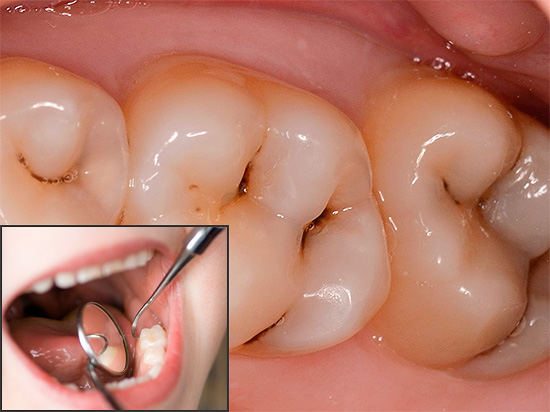
It was established that the first attempts to treat caries could have been made already about 8000 years ago, which is eloquently revealed by the skulls of people whose individual teeth were drilled clearly with a hand tool. Unfortunately, no manuscripts about ancient methods of caries treatment have reached us.
The first records of successful treatment of caries-affected teeth date back to the times of the Roman Empire, when the doctor of the emperor Archigen actually carried out the treatment procedure by drilling a sick tooth with a tool similar to today's manual drill.
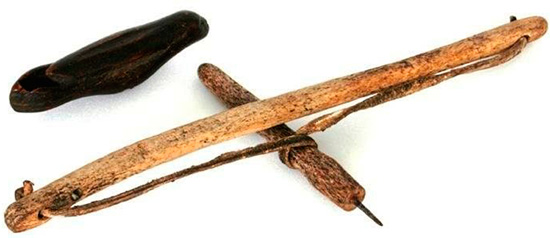
It is interesting
In the 15th century, in an attempt to cure tooth decay, Giovani Arkolani burnt the cavity, filling it with gold. Before that, for many years, dental treatment was limited only to the removal of diseased tissues, often with the tooth itself (if traditional medicine methods did not help).
With the advent of the first drill, which found practical application thanks to the French doctor Fauchard, the treatment of tooth decay became more effective and very productive for that time.
Each year, equipment and materials were improved, new approaches and ideas appeared. We will talk more about how caries is treated today and what a patient can expect in the dentist’s Kremlin.
And what, in fact, are we treating?
Caries is a local pathological process, usually starting under plaque as a result of fermentation (fermentation) of carbohydrate food debris by microorganisms (the main role is attributed to anaerobic Streptococcus mutans, although other bacteria also contribute). As a result of bacterial activity, organic acids are released, which “corrodes” tooth enamel with leaching of minerals from it, which in turn leads to the formation of pores. This is a focal demineralization of enamel (caries in the spot stage) - the first stage of destruction.
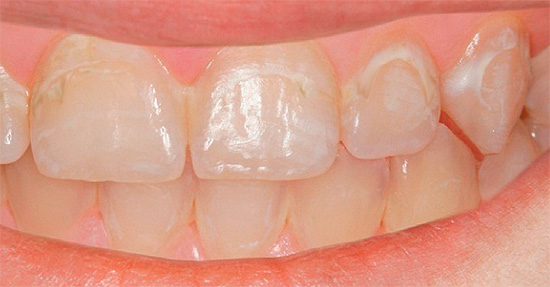
If not timely treatment of initial caries, defects in tooth tissues are formed: superficial, middle and deep carious cavities. Such a process of gradual destruction can be asymptomatic, or with the occurrence of short-term pain from external stimuli (sweet, cold, etc.), quickly passing after eliminating the source of irritation.
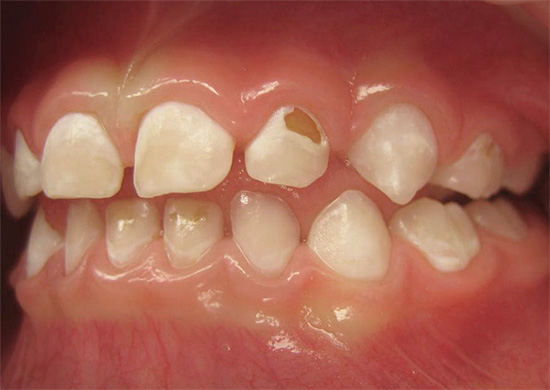
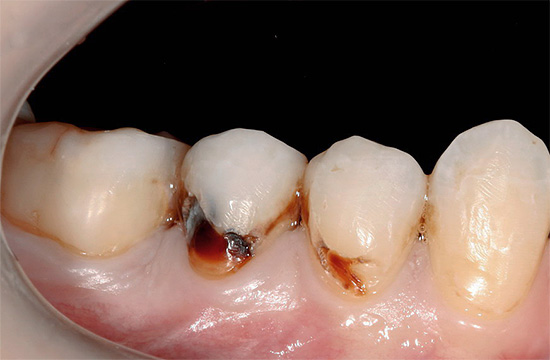
Thus, the treatment of caries involves the restoration of the functional properties of the hard tissues of the tooth: for example, the tooth surface was white, smooth and hard, and instead a dark-colored hole appeared in which, moreover, the hard tissues lost their hardness. Accordingly, the treatment will be aimed at eliminating this hole, removing softened tissues and replacing them with full-fledged solid structures that would be integral with the tooth.
This is a simplified explanation; in fact, there are many interesting nuances here (see below).
General principles for the treatment of caries
Currently, there are two fundamentally different approaches to the treatment of caries:
- Conservative therapy without preparation (that is, without excision of tissues with a drill);
- Treatment with the preparation of hard tooth tissues (that is, it is assumed that everyone knows the “drilling” of teeth).
Conservative techniques are non-invasive methods for treating caries. They are used both for the initial forms at the stage of focal demineralization (spots), and for already formed cavities.
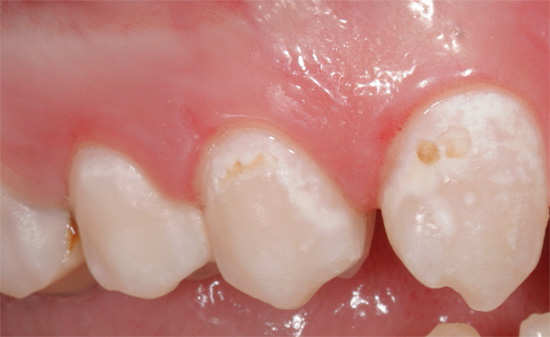
It is interesting
Currently, before the start of dental treatment, including caries, informed consent of the patient to this procedure is required.Manipulation cannot be started without him, since first a document must be signed that explains to the patient the medical and legal aspects that protect his interests. And also this document will protect the doctor in case of unsuccessful treatment, not associated with intentional harm. In addition to consent, the medical history is necessarily filled in the patient's card, where all the manipulations associated with the treatment of caries are recorded in detail.
The treatment of caries using the tissue preparation technique consists of the following steps:
- Preparation of the oral cavity. This may include not only removing plaque or stone from the tooth planned for treatment, but also generally conducting professional hygiene of all teeth.

- Anesthesia (if necessary). In most cases, the treatment of caries is carried out under local anesthesia, but sometimes, for example, with multiple damage to the teeth or with panic fear in young patients, treatment is carried out under anesthesia, that is, with the "turn off" of consciousness. This is a more risky option, but it is justified if there is a medical indication for it.

- Preparation. This stage involves the removal of destroyed tissues from the cavity and subsequent drug treatment with special solutions of antiseptics. This allows you to create all the conditions so that bacteria do not multiply under the future filling, and it does not fall out due to relapse of caries (the so-called secondary caries).

- Cavity formation. This stage is important for creating such a shape of the cavity, which will create additional conditions for holding the seal. Many materials used in the treatment of caries require a specific configuration from the cavity formed. However, among modern filling materials, there are those that chemically bind to the tooth and do not require the creation of mechanical means of retention.

- The imposition of a medical or insulating pad (according to the clinical situation). This stage is especially important for fillings that are placed during deep caries, when it is required to have a long anti-inflammatory and antimicrobial effect on the “nerve” located quite close to the bottom of the formed cavity using special medical pads. Insulating gaskets under the seals are placed in most cases, since almost all materials have an irritating effect on the pulp.

- Cavity filling. During installation, fillings determine its color (when working with aesthetic materials), isolate the working surface from the rest of the oral cavity with a rubber dam or simple cotton rollers, and then actually bring the material into the cavity according to the instructions for it. In this case, a number of additional tools are often used to improve the quality and working conditions: matrices to create a gap between the fillings and adjacent teeth, wedges to form an ideal contact point, retraction thread to correct the gums near the working area, etc.

- And finally, the finish. After installing the seal, a prerequisite is its bite correction, grinding and polishing. It is important that the seal does not injure the tooth, does not cause discomfort and pain, does not have any burrs, does not accumulate plaque, has a gloss characteristic of a normal tooth, etc. For this, for example, they use special disks, polishing heads, finishes or polishes.
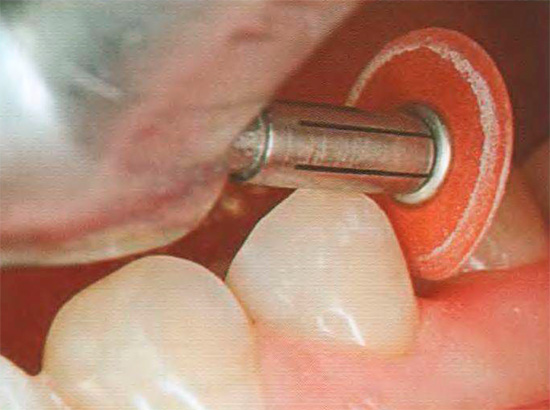
The following video shows an example of a treatment for deep caries:
Drill treatment for deep caries
Classical therapies with preparation
Long before the appearance of modern filling materials, caries treatment was carried out using a preparation (invasive method) and the formation of a carious cavity under the materials used then. At the same time, to fix and securely hold the seals, it was necessary to fulfill a number of conditions related:
- with a large preparation area;
- with the need to comply with certain angles of transition of the walls and the shape of the bottom;
- with a specific configuration of the cavity;
- with the creation of additional cavities and the processing of healthy tooth tissues;
- with the application of boron cuts and clippings.
Such treatment of caries required certain skills, dexterity and a lot of time.
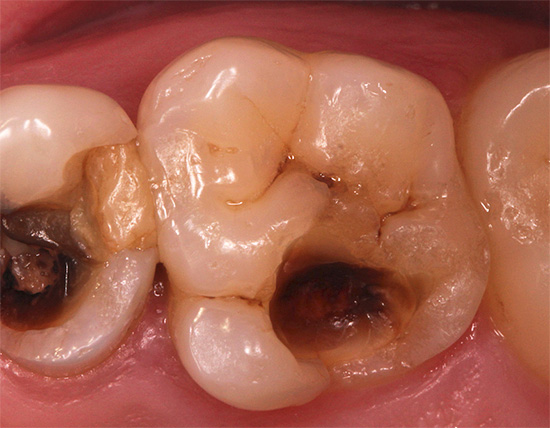
The following are the "classic" materials that were used earlier in dentistry and are still used in budget organizations for permanent fillings:
- Mineral cements (Silicin, Silidont and some others);
- Acrylic and epoxy materials (e.g. Acrylic Oxide);
- Metal fillings (amalgams).
Photo of amalgam fillings:
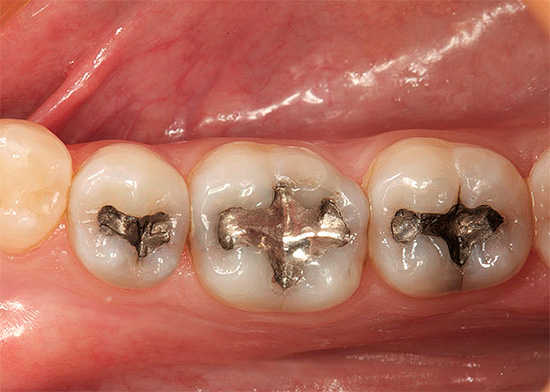
Obviously, before modern methods of treating caries appeared, it took years of work with the use of “classic” filling materials - many people still go with such fillings.
On a note
During the Great Patriotic War, the surgeon Ivan Ivanovich Scheglov widely used the method of healing even the most severe wounds by using lotions with hypertonic sodium chloride solution. In just a few days, the wounds became clean, pink, not festering, which significantly reduced mortality among the wounded. In the future, there was separate evidence that the Shcheglov method can be successfully used to treat complicated caries, more precisely, to relieve inflammation and severe pain in those conditions where there is no way to use more effective methods.
Modern materials for dental fillings
Since the time of unaesthetic and difficult to fix cements and amalgams, more than a dozen years have passed. Modern dentistry required new solutions in the treatment of caries, and they appeared.
First of all, the trend led to the rejection of excessive treatment of the carious cavity and a decrease in the volume of healthy tissues removed by boron, which was previously required only for the mechanical retention of “ancient” fillings.
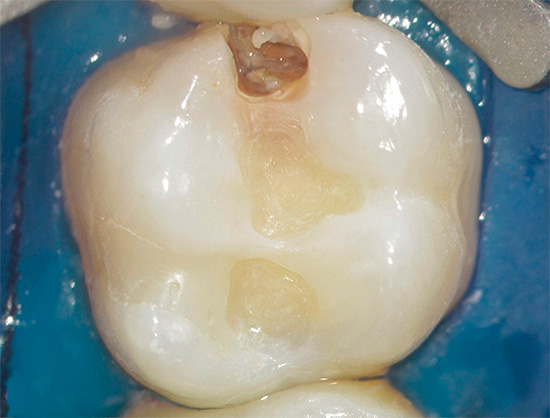
In addition to the mechanical method for treating the carious cavity with boron (that is, a “drill"), other methods have also appeared:
- Chemical-mechanical (dissolution of “caries” by chemical means and its removal with hand tools);
- Air-abrasive (sandblasting the cavity);
- Ultrasonic cleaning of the cavity;
- Laser preparation.
Adhesive techniques have appeared that are associated with the use of special chemicals (“adhesives”), which make it possible to abandon the routine methods of filling fillings and increase tens of times the adhesion of the material to tooth surfaces. Materials have been developed that are biocompatible with tooth tissues and reliable adhesion with minimal preparation and creating an arbitrary cavity shape.
The most popular classes of materials for the treatment of caries:
- Composites;
- Glass ionomer cements;
- Compomers;
- Ormokers.
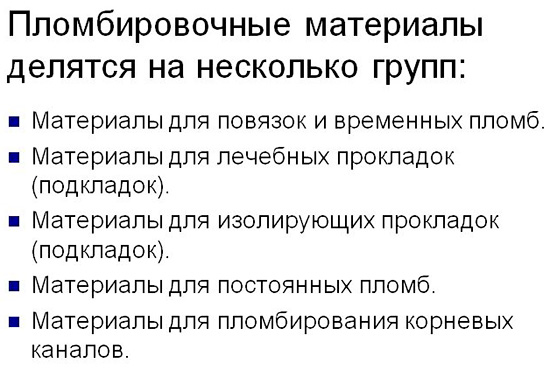
However, within each class of materials there are already categories that are only limitedly used in modern dentistry for the treatment of caries in view of the inefficiency proved over the past decades. Some of the materials have moved into the field of budget dentistry.
Each of the listed materials has its own individual set of properties that can and should be combined to achieve the optimal result for the treatment of caries of milk and permanent teeth for the long term. Moreover, more than one technique has been developed for their competent combination and introduction into the cavity.
Modern approaches to the treatment of deep caries
Deep caries is always associated with very serious tooth decay. And if the stage of the carious spot often does not require mechanical treatment of the cavity (non-invasive method of treatment), and with superficial and medium caries, one can limit oneself to gentle preparation techniques with minimal excision of tissues, then deep caries usually requires a long cavity treatment from the doctor, special preparation modes, and treatment and insulating gaskets for seals.
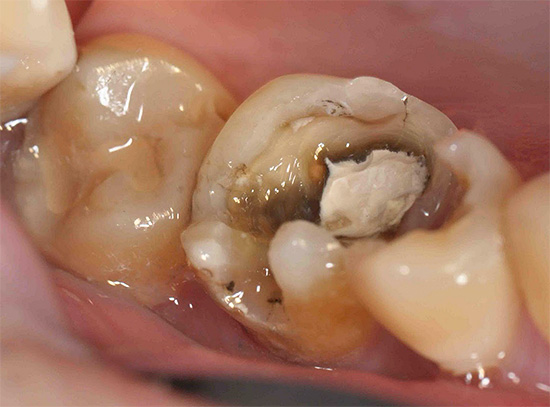
The possibility of preserving the living pulp (“nerve”) is determined by performing a series of manipulations that are important so that tooth decay does not appear again after treatment. Such manipulations include:
- Accurate work with burs, taking into account the anatomy of the tooth;
- Alternating work with high-speed tips and a tip for a micromotor at low speeds at the bottom of the cavity to prevent the risk of accidental opening of the pulp chamber;
- Use of caries-detectors (indicators) for recognition of carious tissues in the cavity;
- Air-water cooling to protect against overheating of the tooth;
- The use of medical pads based on calcium hydroxide;
- The use of insulating gaskets (most often it is glass ionomer cements);
- The use of the technique for treating deep caries in several visits with the control of the therapeutic effect of the used preparations based on calcium hydroxide.
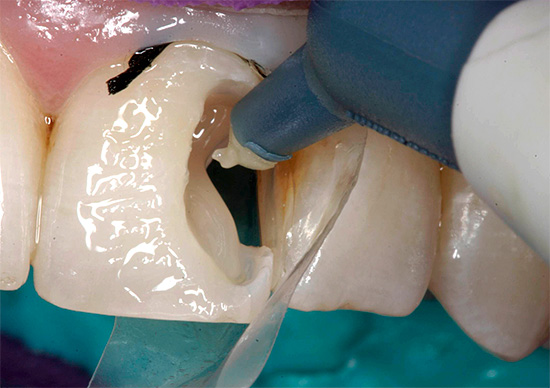
From the practice of the dentist:
The following are widely represented on the market for medical gasket materials:
- An aqueous suspension based on calcium hydroxide (Calradent, Calcicur, Calasept, CalciumHydroxide, Calcipuipe);
- Varnishes based on calcium hydroxide (Contrasil);
- Chemical-curing calcium-salicylate cements (Septocalcine Ultra, Calcesil, Dycal, Life, Calcimol, Alkaliner, Reocap);
- Light-cured materials based on polymers combined with calcium hydroxide (Esterfil Ca, Calcesil LC, Ultra-Blend, CalcimolLC,).
Studies have shown that the greatest therapeutic effect is shown by preparations based on an aqueous suspension of calcium hydroxide, but they are applied under a temporary filling and can cure deep caries in only a few visits, unlike calcium-salicylate cements, which are applied immediately under a permanent filling, but the therapeutic effect they are less pronounced. Most dentists are inclined to believe that varnishes and light-cured medical pads have weak antiseptic and anti-inflammatory effects on the pulp of the tooth.
Caries treatment without a drill
Many people today are concerned about the possibility of treating caries without using a drill. And modern dentistry really has in its arsenal methods that allow this to be done.
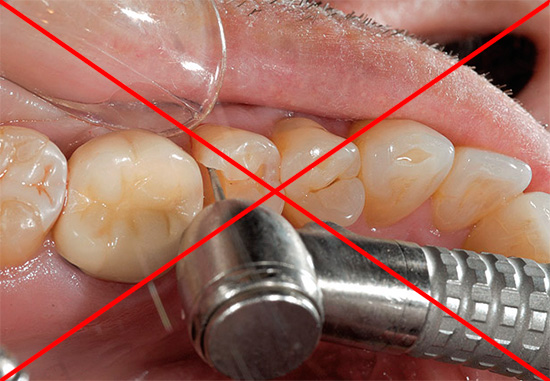
We list the main ones:
- Treatment of the tooth surface with remineralizing compounds;
- Using ICON technology;
- ART technique.
Remineralizing therapy is, in fact, restoration of a partially destroyed enamel crystal lattice, replenishment of its mineral components during focal demineralization. At home, it is difficult to independently select the required combination of drugs and their concentration for the safe and effective treatment of caries in the spot stage, so it is highly advisable to consult a dentist.
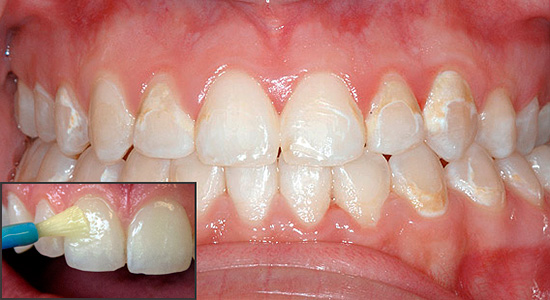
Remineralizing therapy consists of systemic and local events. Systemic include, for example, the appointment of fluorinated salt, milk, fluoride tablets, etc. And for local ones - treatment of the tooth surface with special remineralizing solutions or gels containing calcium, fluorine and phosphorus compounds, and sometimes a number of other important minerals in various combinations for accelerated enamel mineralization.
Examples of preparations for the treatment of caries in the stage of a white spot:
- Multifluoride;
- Bifluoride;
- Belak F;
- Glufthored;
- Enamel-sealing liquid;
- Belagel Ca / P, Belagel F.
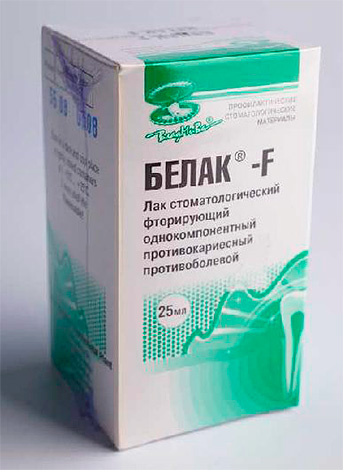
As for ICON technology, it is one of the most promising in the treatment of caries in the spot stage. In addition, for example, with prolonged wearing of braces, demineralization of certain areas of enamel can also occur: in this case, treatment will be required after removal of orthodontic appliances.
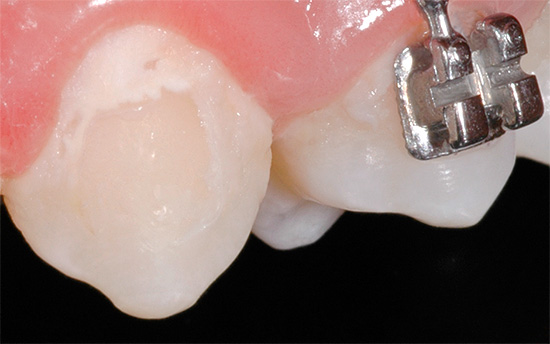
The essence of ICON technology: after the infiltrant is applied and polymerized by a UV lamp, the enamel surface acquires its original color, since the liquid based on polymer resins "flows" into the zones of the damaged enamel crystal lattice and actually "clogs" the micropores. The method of infiltration of the affected enamel structures with the compounds included in the ICON allows you to achieve the result in the first visit.
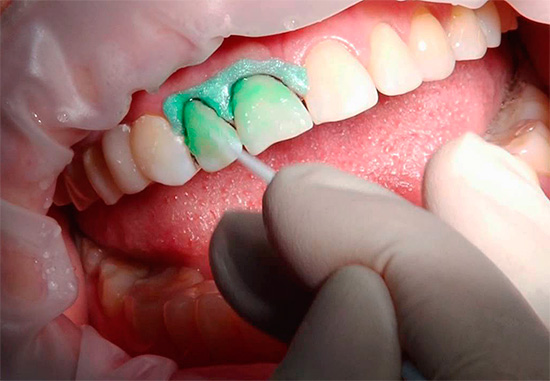
The main condition for treating caries with ICON is to use it only on enamel, since dentin cannot be infiltrated.
In the photos below you can observe some stages of caries treatment using ICON technology:
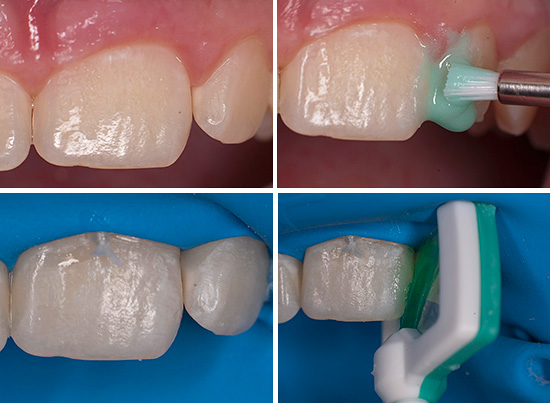
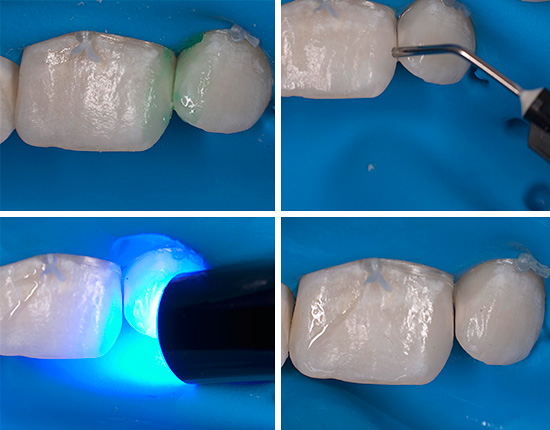
Now a few words about the so-called ART-method for the treatment of caries.
The “classic” ART technique is an atraumatic restorative treatment or non-invasive treatment for caries. It was developed in the Netherlands. Instead of a drill for the treatment of caries, excavators are used - special hand tools that can literally "scrape off" carious infected tissues from the bottom and walls of the cavity. Then the cavity is filled with glass ionomer cement, which releases fluoride in the tissue and stops caries.
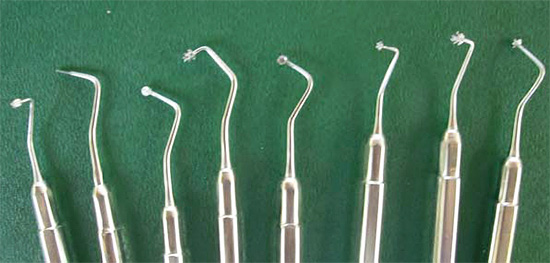
Do not flatter yourself and look for a doctor who is ready to give you caries treatment using the ART method. A hand tool is most often not able to efficiently remove all pigmented and infected tissues from the cavity, which often leads to the need for tooth resuscitation. By the way, at the same time, WHO recommends an ART methodology for active implementation for residents of poor regions, emigrants, refugees, etc.
In some cases, you can apply this technique to people experiencing a panic fear of a drill.
Promising options for the treatment of caries: a sandwich technique
Today, every competent dentist owns information about modern filling materials for the treatment of dental caries. The possibility of combining during work 2-3 different materials gives invaluable benefits, as this allows you to maximize the benefits of each option.
One of the most promising treatment options for caries is the sandwich technique, or, in fact, the “sandwich” technique.
It is interesting
The justification for the use of sandwich technology is due to the fact that composites of light curing, or, otherwise, “light” fillings, have several disadvantages:
- High rates of shrinkage or deformation, which eventually leads to the appearance of a "hole" in the place of the seal;
- Lack of anticariogenic effect;
- Lack of biocompatibility with tooth tissues (have a toxic effect on pulp tissue through the bottom of the cavity).
All these disadvantages are successfully compensated by glass ionomer cements (SIC). Also, a sandwich technique is understood to mean a combination of composites and compomers, as well as amalgams and composites, but they are used less often.
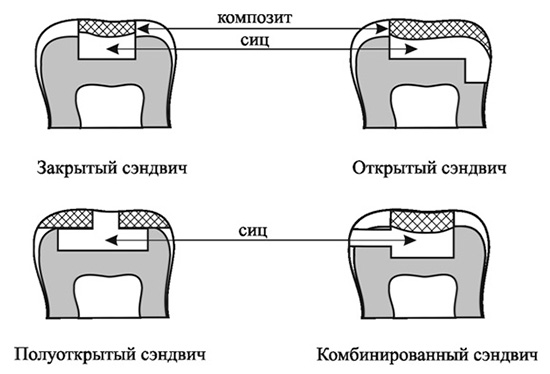
For example, the following algorithms are possible for laying glass ionomer cement in the treatment of caries by the sandwich method:
- Closed sandwich: the gasket does not reach the edges of the cavity, which means it does not come into contact with the oral fluid;
- Open sandwich: a gasket overlaps one of the walls and is in contact with the environment of the oral cavity.
Advantages of the technique:
- Possibilities of laying from SIC for a long time to release fluoride in tooth tissue, which reduces the risk of secondary caries;
- Reducing shrinkage of the seal from the composite, since the SIC reliably compensates for it;
- Improving the natural color characteristics of the future fillings due to the color of the SIC, simulating darker dentin at the bottom;
- Possibilities of SIC to suppress the growth of cariogenic microorganisms;
- Using this technique, as often the only reliable way to fill cervical and subgingival defects, especially with root caries. Due to the poor adhesion of the composites to only one dentin, the inability to create a perfectly dry surface of the gingival and subgingival restorations, the SICs make it possible to create an ideally strong foundation for them, as well as provide the connection of the main filling with tooth tissues through glass ionomer cements.
The photo below shows the tooth before and after the treatment of caries with filling by the sandwich method:
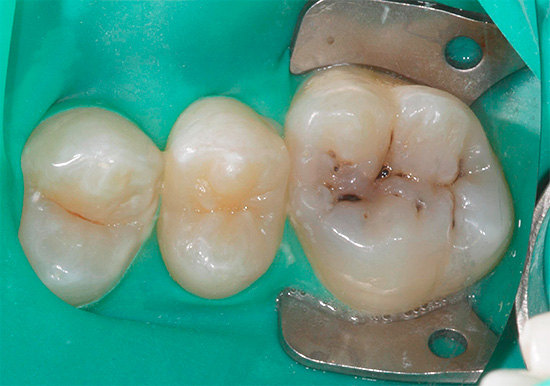
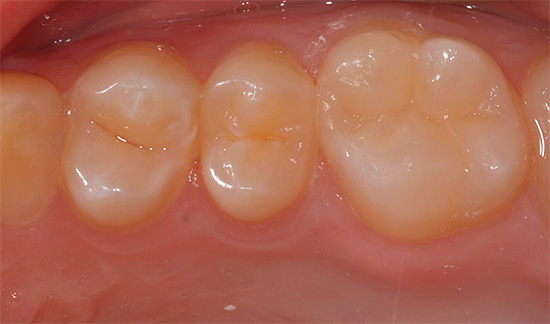
Possible complications of caries treatment: something that too impressionable patients should not know about
During the treatment of caries with one or a combination of several factors (poor equipment, materials, level of training, complicated tooth anatomy, inconveniently located carious cavity, etc.), complications sometimes arise. We list the most popular of them:
- Loss of filling or caries around it. Most often, it is medical errors that provide the cause of fillings. This is due to poor cleaning of the cavity from loose tissue, not removal of infected and pigmented dentin and remnants of demineralized enamel.

- The occurrence of pain in the tooth. In order to cure caries (especially deep), the doctor is required to follow absolutely all instructions, from good air-water cooling when preparing the tooth, to accurately drying the dentin (the dentin should be “sparkling” or slightly moist) and the correct work with medical pads. Tooth overheating, dentin overdrying, accidental opening of the pulp chamber, absence treatment pads for deep caries and other errors lead to pain in the tooth of a different nature, up to the appearance of pulpitis or periodontitis due to the death of the damaged "nerve".
- Lack of contact point. In some cases, in the treatment of caries, some doctors do not restore or poorly restore the natural spaces between the teeth, without which the normal functioning of the tooth is impossible. This especially affects the gingival papilla in the gap between the teeth, which is squeezed by the wrong filling and constantly bleeds, which leads to local periodontitis - resorption of the alveolar bone septum in the teeth adjacent to the filling. This fact can then lead to tooth mobility with a risk of tooth extraction.
The picture below schematically shows examples of mistakes made by doctors in the treatment of caries (and not the worst):
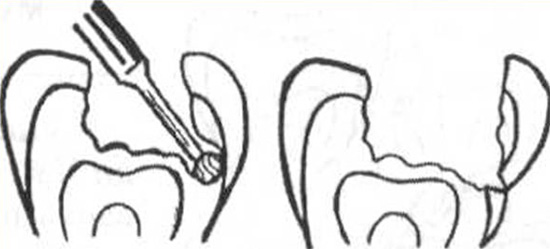
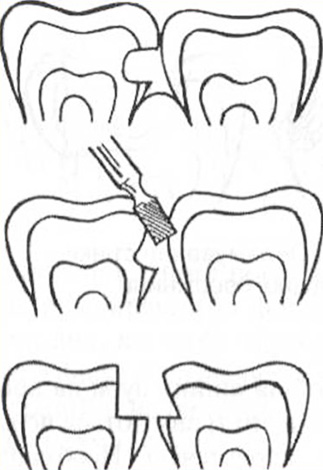
In order not to have to “torment painfully” to treat teeth, it is important to pay considerable attention to the prevention of caries. In most cases, it is enough to follow a number of simple rules to get rid of caries forever:
- To carry out toothbrushing with brushes with pastes containing fluorides, and interdental spaces - with dental floss soaked in fluorine compounds, and after each meal.
- Follow the correct brushing technique, and if necessary, adjust this skill with the dentist.
- If possible, limit your intake of carbohydrates (sweets, cakes ...)
- At least once every 6 months, carry out professional cleaning of teeth from plaque, stone and draw up an individual plan according to the cariogenic situation of the oral cavity and the level of caries resistance (condition of tooth enamel and its mineralization, composition of saliva and its amount).
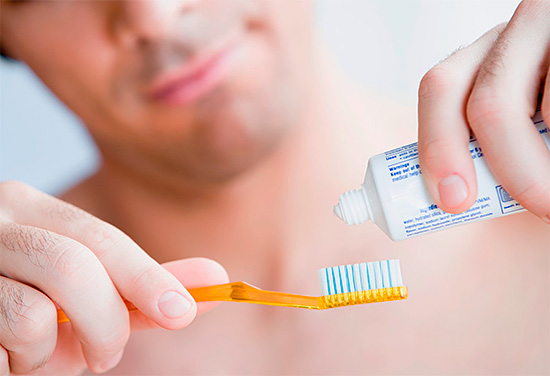
On a note
Not every person can decide to immediately brush their teeth with a toothpaste after eating. Most people seek to extend the pleasure of eating delicious food as long as possible. Moreover, the culture of behavior, established since the days of the Soviet Union, always dictated unreasonable rules: brushing your teeth in the morning and in the evening, forgetting that there are also lunches and snacks during the day, when it is important to remove the forming plaque in time and eliminate cariogenic situation in the oral cavity.
Observing these simple rules, you get a significant chance to keep your teeth healthy until old age and save yourself from caries treatment for life.
Interesting video: it looks like caries treatment under a microscope
Restoration in case of deep caries on the front upper teeth

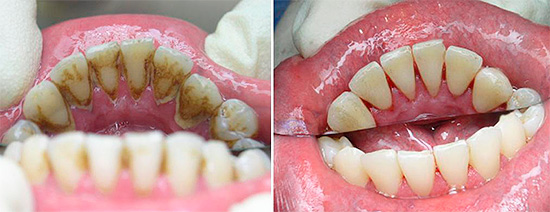
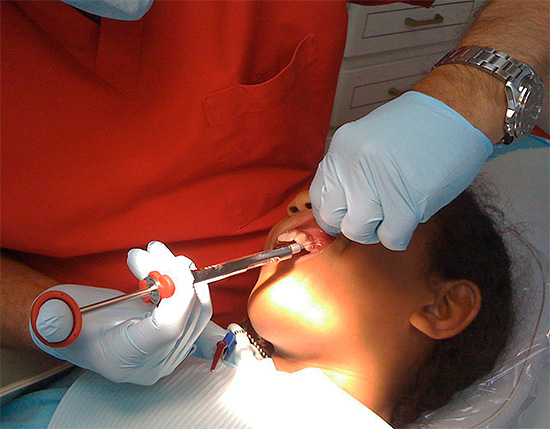
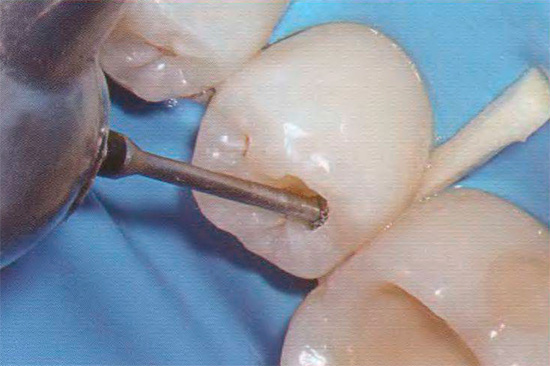
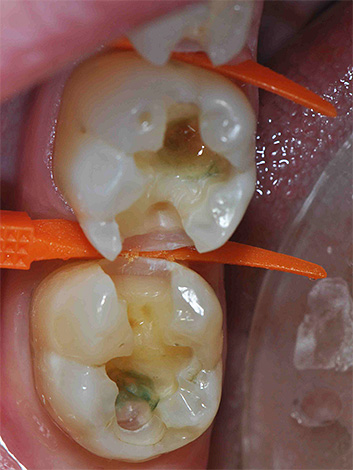
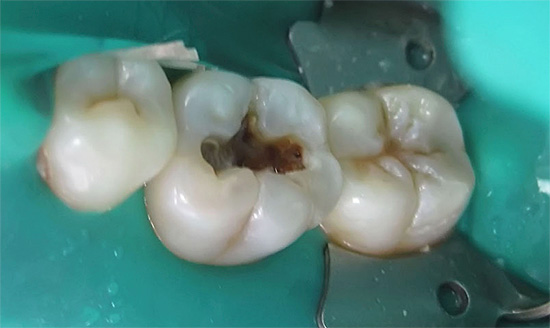
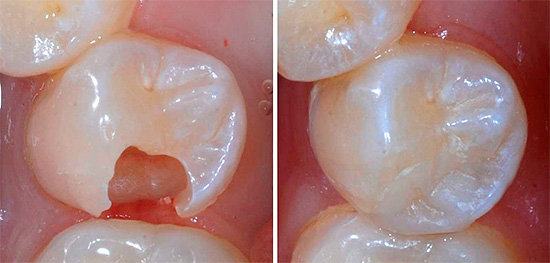
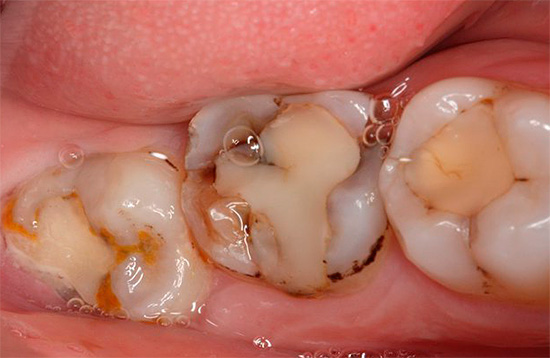
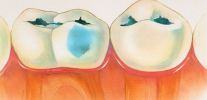
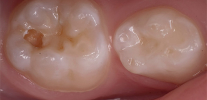
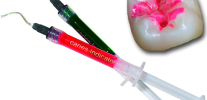
Wonderful article! Pictures, videos, almost everything is chewed to the ground. Respect.
Thank you, the author is a miracle)
An interesting and very informative article.
Thanks! Very informative.
Thanks. Not told about laser treatment.
On many teeth, I have, as it were, deep steps in the gum area (wedge-shaped defects as the doctor said). They don’t hurt, but they don’t look very good and it seems to me that the tooth is weakened because of them, as if cut and if there is a heavy load, it may break along the step line. Do I need to do something with these wedge-shaped defects or do they require no treatment?
Hello Anonymous! A wedge-shaped defect is a non-carious lesion of tooth tissue, which, however, can slowly progress. In the initial stage, if there is no unpleasant pain and aesthetic defect, treatment is not required. If these problems exist, then the wedge-shaped defects must be sealed.
The threat of tooth fracture (due to a wedge-shaped defect) during exercise occurs extremely rarely, except in very late stages.